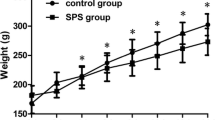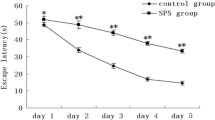Abstract
Ribosomal protein S3 (rpS3), a multi-functional protein, has been known to participate in DNA repair mechanism. In this study, we investigated changes in rpS3 immunoreactivity and its protein levels in the sub-regions of the gerbil hippocampus following subacute and chronic restraint stress. Serum corticosterone levels were increased in both the subacute and chronic-stress-groups compared to the control-group: the level in the subacute-stress-group was much higher than that in the chronic-stress-group. We could not find any neuronal damage in all the sub-regions of the hippocampus after both the subacute and chronic restraint stress. In the subacute-stress-group, rps3 immunoreactivity was not different compared to the control-group. However, rps3 immunoreactivity in the chronic-stress-group was decreased compared to the subacute-stress-group: especially, the immunoreactivity was markedly decreased in the pyramidal cells of the hippocampus proper (CA1–CA3 region) and granule cells of the dentate gyrus. In addition, western blot analysis also showed that rpS3 protein levels in the chronic-stress-group were significantly decreased compared to those in the subacute-stress-group. These findings indicate that chronic stress, not subacute stress, can decrease rpS3 immunoreactivity.





Similar content being viewed by others
References
McEwen BS (1999) Stress and hippocampal plasticity. Annu Rev Neurosci 22:105–122
McEwen BS (2000) The neurobiology of stress: from serendipity to clinical relevance. Brain Res 886:172–189
Sapolsky RM (1996) Why stress is bad for your brain. Science 273:749–750
Song L, Zheng J, Li H et al (2009) Prenatal stress causes oxidative damage to mitochondrial DNA in hippocampus of offspring rats. Neurochem Res 34:739–745
Tagliari B, Tagliari AP, Schmitz F et al (2011) Chronic variable stress alters inflammatory and cholinergic parameters in hippocampus of rats. Neurochem Res 36:487–493
Uno H, Tarara R, Else JG et al (1989) Hippocampal damage associated with prolonged and fatal stress in primates. J Neurosci 9:1705–1711
McIntosh LJ, Sapolsky RM (1996) Glucocorticoids increase the accumulation of reactive oxygen species and enhance adriamycin-induced toxicity in neuronal culture. Exp Neurol 141:201–206
Cochrane CG (1991) Mechanisms of oxidant injury of cells. Mol Aspects Med 12:137–147
Kyng KJ, Bohr VA (2005) Gene expression and DNA repair in progeroid syndromes and human aging. Ageing Res Rev 4:579–602
Pham K, Nacher J, Hof PR et al (2003) Repeated restraint stress suppresses neurogenesis and induces biphasic PSA-NCAM expression in the adult rat dentate gyrus. Eur J Neurosci 17:879–886
Vyas A, Mitra R, Shankaranarayana Rao BS et al (2002) Chronic stress induces contrasting patterns of dendritic remodeling in hippocampal and amygdaloid neurons. J Neurosci 22:6810–6818
Consiglio AR, Ramos AL, Henriques JA et al (2010) DNA brain damage after stress in rats. Prog Neuropsychopharmacol Biol Psychiatry 34:652–656
Sosnovskii AS, Kozlov AV (1992) Increased lipid peroxidation in the rat hypothalamus after short-term emotional stress. Biull Eksp Biol Med 113:486–488
Jang CY, Lee JY, Kim J (2004) RpS3, a DNA repair endonuclease and ribosomal protein, is involved in apoptosis. FEBS Lett 560:81–85
Kim J, Chubatsu LS, Admon A et al (1995) Implication of mammalian ribosomal protein S3 in the processing of DNA damage. J Biol Chem 270:13620–13629
Kim SH, Kim J (2006) Reduction of invasion in human fibrosarcoma cells by ribosomal protein S3 in conjunction with Nm23-H1 and ERK. Biochim Biophys Acta 1763:823–832
Wilson DM 3rd, Deutsch WA, Kelley MR (1993) Cloning of the Drosophila ribosomal protein S3: another multifunctional ribosomal protein with AP endonuclease DNA repair activity. Nucleic Acids Res 21:2516
Hwang IK, Yoo KY, Kim DW et al (2008) Ischemia-induced ribosomal protein S3 expressional changes and the neuroprotective effect against experimental cerebral ischemic damage. J Neurosci Res 86:1823–1835
Park JH, Yoo KY, Lee CH et al (2011) Comparison of glucocorticoid receptor and ionized calcium-binding adapter molecule 1 immunoreactivity in the adult and aged gerbil hippocampus following repeated restraint stress. Neurochem Res 36:1037–1045
Choi SH, Kim SY, An JJ et al (2006) Immunohistochemical studies of human ribosomal protein S3 (rpS3). J Biochem Mol Biol 39:208–215
Schmued LC, Hopkins KJ (2000) Fluoro-Jade B: a high affinity fluorescent marker for the localization of neuronal degeneration. Brain Res 874:123–130
Yu JT, Lee CH, Yoo KY et al (2010) Maintenance of anti-inflammatory cytokines and reduction of glial activation in the ischemic hippocampal CA1 region preconditioned with lipopolysaccharide. J Neurol Sci 296:69–78
Feldman S, Conforti N (1980) Participation of the dorsal hippocampus in the glucocorticoid feedback effect on adrenocortical activity. Neuroendocrinology 30:52–55
Herman JP, Schafer MK, Young EA et al (1989) Evidence for hippocampal regulation of neuroendocrine neurons of the hypothalamo-pituitary-adrenocortical axis. J Neurosci 9:3072–3082
Kim JJ, Diamond DM (2002) The stressed hippocampus, synaptic plasticity and lost memories. Nat Rev Neurosci 3:453–462
Sapolsky RM, Krey LC, McEwen BS (1985) Prolonged glucocorticoid exposure reduces hippocampal neuron number: implications for aging. J Neurosci 5:1222–1227
Madrigal JL, Caso JR, de Cristobal J et al (2003) Effect of subacute and chronic immobilisation stress on the outcome of permanent focal cerebral ischaemia in rats. Brain Res 979:137–145
Lee YJ, Choi B, Lee EH et al (2006) Immobilization stress induces cell death through production of reactive oxygen species in the mouse cerebral cortex. Neurosci Lett 392:27–31
Fontella FU, Siqueira IR, Vasconcellos AP et al (2005) Repeated restraint stress induces oxidative damage in rat hippocampus. Neurochem Res 30:105–111
Muqbil I, Azmi AS, Banu N (2006) Prior exposure to restraint stress enhances 7,12-dimethylbenz(a)anthracene (DMBA) induced DNA damage in rats. FEBS Lett 580:3995–3999
Sapolsky RM, Krey LC, McEwen BS (1986) The neuroendocrinology of stress and aging: the glucocorticoid cascade hypothesis. Endocr Rev 7:284–301
Sousa N, Madeira MD, Paula-Barbosa MM (1998) Effects of corticosterone treatment and rehabilitation on the hippocampal formation of neonatal and adult rats. An unbiased stereological study. Brain Res 794:199–210
Benkovic SA, O’Callaghan JP, Miller DB (2009) Protracted exposure to supraphysiological levels of corticosterone does not cause neuronal loss or damage and protects against kainic acid-induced neurotoxicity in the hippocampus of C57BL/6 J mice. Neurotoxicology 30:965–976
Kim BS, Kim MY, Leem YH (2011) Hippocampal neuronal death induced by kainic acid and restraint stress is suppressed by exercise. Neuroscience 194:291–301
Kim SH, Lee JY, Kim J (2005) Characterization of a wide range base-damage-endonuclease activity of mammalian rpS3. Biochem Biophys Res Commun 328:962–967
Lee CH, Yoo KY, Choi JH et al (2011) Ribosomal protein s3 immunoreactivity in the young, adult and aged gerbil hippocampus. J Vet Med Sci 73:361–365
Lee HC, Chang DE, Yeom M et al (2005) Gene expression profiling in hypothalamus of immobilization-stressed mouse using cDNA microarray. Brain Res Mol Brain Res 135:293–300
Fontella FU, Cimarosti H, Crema LM et al (2005) Acute and repeated restraint stress influences cellular damage in rat hippocampal slices exposed to oxygen and glucose deprivation. Brain Res Bull 65:443–450
Acknowledgments
The authors would like to thank Mr. Seung Uk Lee for their technical help in this study. This work was supported by 2011 Research Grant from Kangwon National University, and by Mid-career Researcher Program from the NRF Grant funded by the MEST (2009-0086319).
Author information
Authors and Affiliations
Corresponding authors
Additional information
Joon Ha Park and Choong Hyun Lee contributed equally to this article.
Rights and permissions
About this article
Cite this article
Park, J.H., Lee, C.H., Yan, B.C. et al. Changes in Ribosomal Protein S3 Immunoreactivity and its Protein Levels in the Gerbil Hippocampus Following Subacute and Chronic Restraint Stress. Neurochem Res 37, 1428–1435 (2012). https://doi.org/10.1007/s11064-012-0727-z
Received:
Revised:
Accepted:
Published:
Issue Date:
DOI: https://doi.org/10.1007/s11064-012-0727-z




